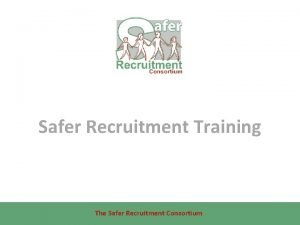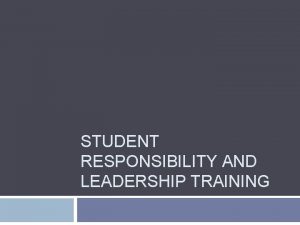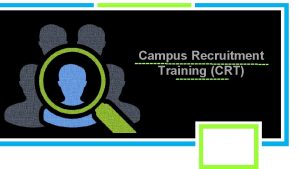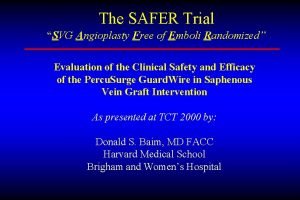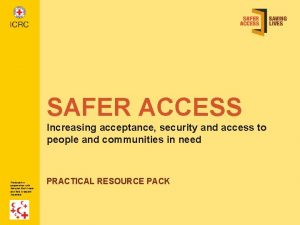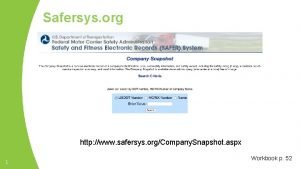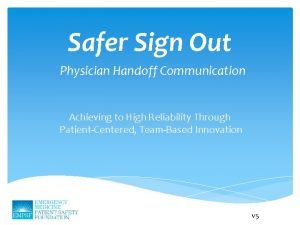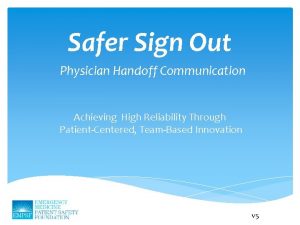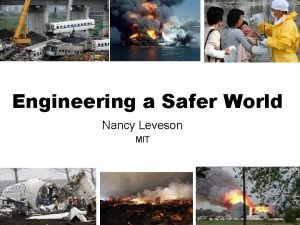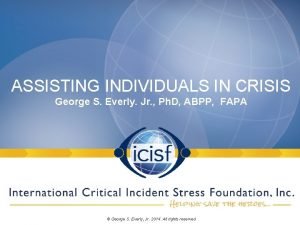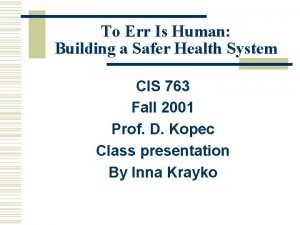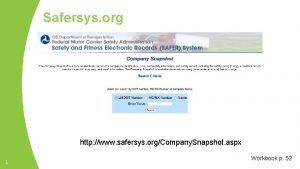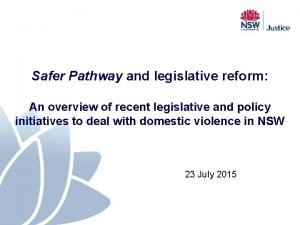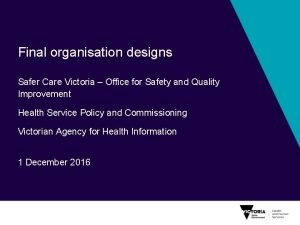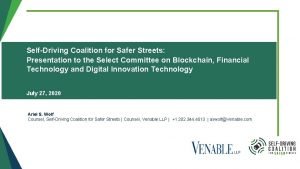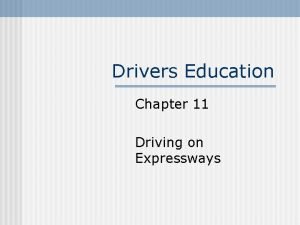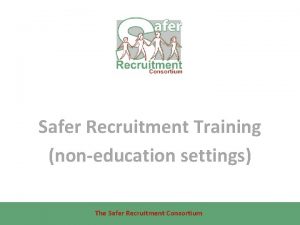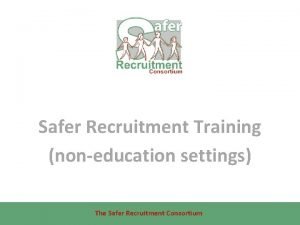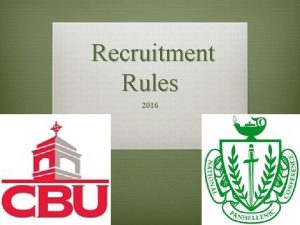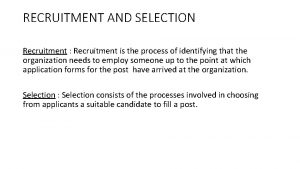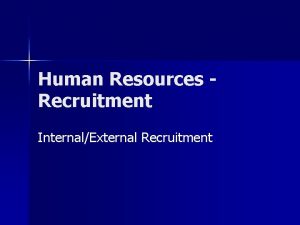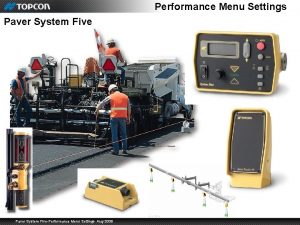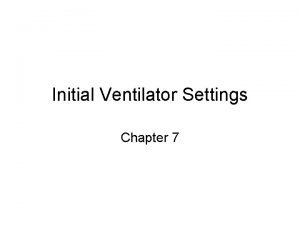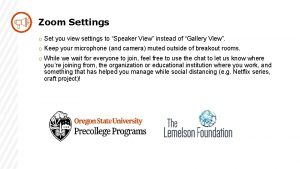Safer Recruitment Training noneducation settings The Safer Recruitment














































































- Slides: 78

Safer Recruitment Training (non-education settings) The Safer Recruitment Consortium

The Bichard Inquiry Recommendations for schools Recommendation 16: • Head teachers and school governors should receive training on how to ensure that interviews to appoint staff reflect the importance of safeguarding children. Recommendation 17: • From a date to be agreed, no interview panel to appoint staff working in schools and colleges should be convened without at least one member being properly trained. The Safer Recruitment Consortium

Objectives of the training Based on an understanding of offender behaviour to: • Identify the key features of staff recruitment that help deter or prevent the appointment of unsuitable people • Consider policies and practice that minimise opportunities for abuse or ensure its prompt reporting • Help participants begin to review their policies and practice in recruitment with a view to creating a safer culture NB this is not intended to be a comprehensive workshop on staff recruitment and selection The Safer Recruitment Consortium

Training outline • Scale of the problem – abused and abuser • A model to understand abusers / abusing • Application into a wider children’s workforce context • Prevention of abuse through recruitment/selection • Ongoing culture of vigilance The Safer Recruitment Consortium

Group agreement • R espect people’s right to speak and be heard • E mbrace diversity and Enjoy the course • S haring information and confidentiality • P articipate safely • E xpress your views and opinions • C hallenge appropriately • T reat yourself kindly The Safer Recruitment Consortium

Session 1 – setting the context for safer recruitment • Background and context • The scale of abuse • A model of offending behaviour • Some characteristics of abusers • Implications for recruitment and selection and creating a safer environment for children and young people The Safer Recruitment Consortium

The wider context • The Bichard Inquiry Report • Legal duties on a wide range of organisations to safeguard and promote the welfare of children (Children Act 1989 / 2004) • Statutory guidance ‘Working together to safeguard children’ (Df. E 2018) • Likely outcomes of Jimmy Saville inquiries for health and other care services • Adopting “safer recruitment” practice is an essential feature of the arrangements organisations need to have in place The Safer Recruitment Consortium

Exercise 1 – what is abuse? There are four categories of child abuse: physical, sexual, emotional or by neglect Discuss how children might be harmed by a worker in your setting: • By accident • As a result of neglect • Deliberately The Safer Recruitment Consortium

Statistics – LADO referrals • About 40% of allegations are for physical abuse and 36% for sexual abuse • Varied significantly across different regions but 12 – 24% relate to emotional abuse or neglect • Where it is recorded as a separate category, 9% of allegations relate to conduct outside the workplace • Schools make up 1/3 rd of all LADO referrals Review of LSCB annual reports 2015 -16 / 2016 -27 (Eyre 2017) The Safer Recruitment Consortium

Statistics - DBS • 7, 727 referrals for discretionary barring in 2017/18 • There were 62, 995 people on the children’s barred list in June 2018 • There were 68, 174 people on one or both lists • Approx 330, 000 enhanced DBS certificates processed each month • On average, 6% include PNC data • 0. 2% also include additional info after filtering has been applied • 0. 01% of DBS applications have a barred list match Disclosure & Barring Service July 2018 The Safer Recruitment Consortium

Children’s experiences of sexual abuse Protecting children from harm (Children’s Commissioner Nov 2015) suggests that approximately 1 in 8 victims of CSA come to the attention of statutory agencies. This finding is consistent with various other pieces of research. Data suggests that about 2/3 rds of cases are within the family environment

Reasons victims don’t report abuse it was nobody else’s business didn’t think it was serious or wrong didn’t want parents to find out didn’t want friends to find out didn’t want the authorities to find out frightened didn’t think they would be believed desire to protect the abuser / abuser is main carer • communication difficulties • • The Safer Recruitment Consortium

Who are the sex offenders? • 97. 8% of those charged with a sexual offence are male • Victim studies suggest that 1 in 9 sexual offences are committed by a woman • Between 2004 – 2009 Childline saw a 132% increase in number of children reporting sexual abuse by a woman Source: Darling 2017 “Between 23 -40% of alleged sexual abuse of children and young people is perpetrated by other young people, mainly adolescents” Source: Harmful sexual behaviour NSPCC 2013 “The majority of perpetrators sexually assault children known to them, with about 80% of offences taking place in the home of either the offender or the victim” Source: Sexual Offending against Children: Understanding the Risk Grubin (1998) The Safer Recruitment Consortium

Finkelhor – four preconditions Adapted from D Finkelhor Child Sexual Abuse: New Theory & Research 1986 Sex with a child Thoughts Motivation Internal inhibitors ‘wanting to’ ‘conscience’ The Safer Recruitment Consortium External inhibitors Overcome victim resistance ‘creating opportunity’ ‘doing it and getting away with it’

Exercise 2 - audio presentation The grid provided in your hand-out contains the stages of Finkelhor’s model • As the clip plays write down, in the appropriate box, what the offender says about this pattern of abusing The Safer Recruitment Consortium

‘Professional perpetrators’ 92. 5% aware of interest by 21 67. 5% offended by 21 15% chose career solely to abuse 41. 5% state abuse part of motivation 77. 5% arranged meetings outside work for abuse • 67. 5% took children away overnight • Average of 49 admitted victims • 41. 9% had reputation as ‘touchy’, ‘pervy’ etc. • • • Source: Sullivan & Beech 2004 – Sample of 41 workers with children who were serious sexual offenders The Safer Recruitment Consortium

A culture of vigilance - learning lessons • Safer recruitment procedures not in place • Lack of safe working practice guidance - staff unclear on boundaries • Standard operating procedures not being followed • Poor management oversight / issues identified in inspection not actioned • Voice of parents / pupils not heard • Voice of staff / whistleblowing – raising concerns / exit interviews • Human / professional / personal relationships • Lack of effective supervision • Ineffective governance and challenge The Safer Recruitment Consortium

Other behaviours often displayed include: • Poor boundary keeping • Breaching policy or procedures ‘in the best interests’ of the child, client or organisation • Lack of awareness of their behaviour on others • Charismatic • Dutiful, over-helpful and committed The Safer Recruitment Consortium

Applying the Finkelhor model to recruitment • Deter • Reject • Prevent Application stage • Prevent & Detect Developing and maintaining a culture of vigilance The Safer Recruitment Consortium Interview stage Appointment and induction

“For those agencies whose job it is to protect children and vulnerable people, the harsh reality is that if a sufficiently devious person is determined to seek out opportunities to work their evil, no one can guarantee that they will be stopped. Our task is to make it as difficult as possible for them to succeed. . . ” Bichard Inquiry Report, 2004, p 12 para 79 The Safer Recruitment Consortium

Safer recruitment assessment The Safer Recruitment Consortium

Safer Recruitment Assessment • You will now be shown 13 questions which should be answered as directed • Ample time will be given to answer each question. After the assessment you will be awarded a certificate which will indicate the score achieved You will then need to identify targets for future professional practice and review. This should be presented as a completed Safer Culture questionnaire and action plan for your organisation The Safer Recruitment Consortium

Question 1: Session 1 Which three of the following are accurate statements about child sex offenders? A Most mask their sexual preferences with apparently fulfilling sexual relationships with adults B Most will aim to create an environment in which they can exploit vulnerable children C The majority of professionals who sexually abuse children enter the profession with the intention of abusing D They have convinced themselves that abusing children is acceptable E Many strive to be seen as respectable adults with children’s welfare at heart The Safer Recruitment Consortium

Question 2: Session 1 Describe a typical sequence of grooming activities by placing the listed activities in the order you think is correct: A Develop a relationship with a susceptible child B Access an environment where there are opportunities for contact with children C Test the boundaries of each child to identify those who show the least rejection of physical contact D Build positive relationships within the organization The Safer Recruitment Consortium

Session 2: a safer recruitment process • Features of a safer recruitment process for : employees, contractors, agencies & volunteers • Sending the right message • The application form • The selection criteria • References • Review and next steps The Safer Recruitment Consortium

Exercise 3: what does a safer recruitment process look like? • Each group has a set of cards showing the activities that make up the recruitment and selection process • In groups take 10 minutes to put the cards in the order of the sequence of activities from identifying a vacancy to making an appointment • Group together any activities that could be done at the same time. Also identify 2 activities that are “red herrings” The Safer Recruitment Consortium

Defining the role • Produce a job description and person specification or volunteer role profile • Include skills, abilities, experience, behaviours and attitude/motivation and values towards children and young people • Boundaries of role and expectations • Responsibilities and opportunity for contact with vulnerable groups – is it Regulated Activity? The Safer Recruitment Consortium

Advertising: Sending the right message Three deterrents • State the organisation’s commitment to safeguarding and/or the need for DBS and other vetting checks in adverts • Include statements about the safeguarding responsibilities of the post in the job description and person specification • Send information about the organisation’s safeguarding policy and practices to candidates The Safer Recruitment Consortium

Key information on application forms • Personal details • Present employment and reason for leaving • Full history since leaving school (education and employment or voluntary work) • Qualifications • Referees • Personal statement to meet person specification • Signed declaration about relevant criminal record • Signed declaration that all information is true The Safer Recruitment Consortium

Criminal background: Self-disclosures Purpose • To give candidates an opportunity to share relevant information at an early stage • To allow information to be discussed and considered before the DBS check comes back • To deter unsuitable people Process • • It is discriminatory to use disclosed information for shortlisting Only consider the information of shortlisted candidates Should not rule someone out – apply fair assessment criteria Continue with DBS check and compare information The Safer Recruitment Consortium

Agreeing selection criteria and process • Base criteria for shortlisting and assessment process on person specification and job description • Consistent for all candidates • Specific to work with children • Review criteria regularly The Safer Recruitment Consortium

Scrutinising applications and short listing Take time to properly scrutinise At least two people shortlisting Identify any inconsistencies Application form fully completed Evidence provided relating to person specification and job description • Scrutinise for gaps • Apply shortlisting criteria equally • • • The Safer Recruitment Consortium

Exercise 4 – short listing In your groups • Use the example person specification, job description and completed application form • Choose 1 of the criteria in the person spec that is relevant to safeguarding children • Use the information on the application form to score the candidate against the chosen criterion • Also scrutinise the application form and consider whethere any gaps or inadequacies in the information provided or the way the form has been completed Would you shortlist the candidate? The Safer Recruitment Consortium

References Important part of process of gathering information: • Must have a reference from current employer • If not currently working with children but has done so in the past, at least one reference should be from that employment • Ask whether aware of any behaviour that might give rise to concern, including any disciplinary action • Ask specifically about allegations about their behaviour towards children • Specific confirmation of the details and responsibilities of previous post given by applicant • Consideration of any request by an applicant to delay seeking references from their current employer The Safer Recruitment Consortium

Open references and testimonials Candidates may sometimes bring ‘open’ references or letters of recommendation to interview. These: • May be the product of a settlement agreement to avoid disciplinary action • Should never be accepted at face value Always take up your own references and/or contact the author of the open reference to verify the content The Safer Recruitment Consortium

Scrutinising references • Importance of reading references – active consideration • Equally, importance of comparing information provided by referee with information provided by applicant • If any inconsistencies, or doubts about suitability, follow up and explore with referee • Where possible, employer should verify that electronic references are from a legitimate source • In residential settings, references should always be confirmed by telephone The Safer Recruitment Consortium

Safer recruitment assessment The Safer Recruitment Consortium

Question 3: Session 2 What is the main reason for including the phrase ‘required to provide a DBS certificate at the appropriate level’ and/or a statement about the employer’s commitment to safeguarding in a job advert? A To obtain specific information on the individual and any prior convictions / cautions or bind-overs B To satisfy a legal requirement C To encourage suitable applicants to apply for the post D To deter unsuitable applicants from applying for the post The Safer Recruitment Consortium

Question 4: Session 2 From a safeguarding perspective, what is the most important reason for only accepting fully completed standard application forms from applicants? A To reveal any gaps in an applicant’s history B To judge applicants against the same criteria C To ensure consistency of information D To meet equal opportunities requirements The Safer Recruitment Consortium

Question 5: Session 2 An applicant supplies an open reference with her application form. Which three of the following statements about an open reference are true? A It is as useful as a normal reference B It might be the product of a settlement agreement C It suggests the applicant might not want you to contact a previous employer D It will save you time and effort in writing for a reference E It should never be considered as part of the recruitment process. The Safer Recruitment Consortium

Session 3: making the right decisions • • • Importance of making the right decision The interview and the selection process Pre-appointment checks Using criminal disclosure information Review and next steps The Safer Recruitment Consortium

Safer selection Good practice • Range of selection tools – not just an interview • Explore motives/attitudes as well as skills and experience • Assessors should be well briefed or trained • Assess interaction with others – role plays, group exercises • Appropriate involvement of children The Safer Recruitment Consortium

Selecting the right people Interviews • At least two people • Structured questions and criteria previously agreed • Probe gaps, frequent changes in employment, vagueness or areas of concern • Ask about attitudes towards child protection / safeguarding and where appropriate motives for working with vulnerable groups • Avoid hypothetical questions and seek positive examples or evidence • Clearly document your decisions • Beware of prejudices and discrimination The Safer Recruitment Consortium

Making decisions using selection criteria and indicators • Based on the Person Specification • Indicators – what would you expect a good candidate to say? • Guide not a tick box • Bespoke to the position • Use to make decisions and clarify why someone is suitable or unsuitable for appointment • Review regularly The Safer Recruitment Consortium

Areas of potential concern • No understanding or appreciation of children’s needs • Wanting role to meet own needs at the expense of children • Inappropriate language when talking about children • Expression of views that are extreme or do not support safeguarding • Unclear boundaries with children • Vagueness about experiences and gaps or unable to provide any examples to support what they tell you • Maverick – non rule-following, unwilling to work with others The Safer Recruitment Consortium

Exercise 5 – Interview questions • Identify one criterion from the person specification relevant to safeguarding • Devise an interview question that would test out a candidate’s attitudes, motives and suitability for this role • Discuss what you would expect to hear from a candidate in response to the question you have devised and write down some positive and negative indicators There is an example ‘interview assessment form’ on page 33 of the delegate workbook The Safer Recruitment Consortium

Interview question template Positive Indicators Emotional Resilience & Maturity • Consistent under pressure • Has control over emotions • Knows when to seek help • Tell me about a • Inappropriate time when your responses under authority was pressure or when challenged. in charge of • What happened? others. • How did you react? • Handles conflict • What did you do to badly. bring things back on • Doesn’t seek help course? when needed. The Safer Recruitment Consortium Negative Indicators

Pre-appointment checks A conditional offer of employment can be made pending the following checks: • Identity - including DOB • Eligibility to work in the UK • DBS Barred List (replaced List 99/Po. CA/Po. VA lists in 2009) • Enhanced DBS certificate • Qualifications • Status: HCPC, BACP registration, etc • Disqualification from childcare / disqualification by association / disqualification from caring for children • Overseas checks (e. g. police check / certificate of good conduct / overseas reference) The Safer Recruitment Consortium

Regulated activity & DBS checks • Individuals employed to work regularly in a specified place or certain roles are in regulated activity (RA) with children • It is a legal requirement to check people working in RA are not barred from that work before they commence in post • People not in RA can still be asked to undertake a DBS disclosure (without Barred list check) • It is unlawful to check the Barred list if the person is not in RA • Employer must see the original certificate and should only retain a copy in certain circumstances The Safer Recruitment Consortium

DBS Barred list - children At present people are barred by law from working in RA with children if they are: • on the DBS children’s barred list • banned by a court on conviction of a specified offence A DBS certificate obtained in regard to work with children will usually* show whether the person is barred from RA with children. * But not in the case of supervised volunteers People barred from working in RA with adults are not automatically barred from working with children or vice versa The Safer Recruitment Consortium

Exercise 6 Relevance of criminal offences Look at the list of offences • Discuss whether you think these offences should deem someone unsuitable for working with vulnerable groups, have no relevance or would be a grey area? The Safer Recruitment Consortium

Relevance of criminal records When assessing an applicant’s criminal history, consider the offence in terms of • Nature, seriousness and relevance • How long ago it occurred • Whether it was a one-off or part of a history • Circumstances of it being committed • Changes in applicant’s personal circumstances • Country of conviction • Decriminalisation It is unlawful to take offences that are ‘protected’ into account The Safer Recruitment Consortium

Protected offences • The Rehabilitation of Offenders Act 1974 was amended in 2013 • Employers should not ask candidates to disclose spent convictions, even if the post is exempt from the ROA • Legislation now refers to ‘filtered’ or ‘protected’ offences which applicants do not need to disclose • It is the employer’s responsibility to draw applicants’ attention to the guidance on disclosure of offences that are not ‘protected’ or ‘filtered’ • See p 18 of the delegate workbook for the wording recommended by the Home Office – this should be used on application forms, applicant information packs, etc • If an applicant discloses an offence which they did not need to, it is the recruiter’s responsibility to know not to discuss / take it into consideration The Safer Recruitment Consortium

Safer recruitment assessment The Safer Recruitment Consortium

Question 6: Session 3 Which one of the following statements describe a best practice approach to interviewing? A Before conducting the interviews, the panel should agree a completely identical set of questions for all candidates and should not deviate from them B The interview panel should consistently pose hypothetical questions in order to uncover an applicant's attitudes about unsuitable behaviour C The interview panel should agree questions for all applicants relating to the requirements of the role and the person specification including questions for each one relating to the information provided on his/her application form and in references. The Safer Recruitment Consortium

Question 7: Session 3 In an interview, you ask the candidate if he can think of a recent situation in which he took action to help protect a child. In response, he describes a situation in which one of the girls attending his project had been threatened by an ex-boyfriend. He explains that he gave her a lift home a few times because she was worried about the boy. Considering his response, which one of the following statements about the candidate do you think is most accurate? A His behaviour demonstrated a good understanding of safeguarding B His behaviour supported a safe culture in the organisation C His behaviour was justified in the context D His behaviour was inappropriate The Safer Recruitment Consortium

Question 8: Session 3 A local resident volunteers to come in every Friday to help. She will be working in the main room and will be supervised by staff. In order to minimise the risk to children, which one of the following is the correct level of checks for this situation? A Barred list check only B Enhanced DBS certificate with barred list check C No checks D Enhanced DBS certificate without barred list check The Safer Recruitment Consortium

Question 9: Session 3 In an interview, you ask the candidate about how he approaches discipline in group work. He says: “I never have any discipline problems. The kids know exactly where they stand with me. ” Considering his response, what question do you think you should ask next? A That's great. We need people who are effective managers. B Please describe a recent situation where you had to deal with disruptive behaviour and explain what action you took? C What do you think you would do if a young person used offensive language towards others? D Have you ever had an allegation of physical violence brought against you? The Safer Recruitment Consortium

Session 4: an ongoing culture of vigilance • • • Features of a safer culture Audio presentation Creating an open culture Individual responsibilities for expressing concern Dealing with allegations of professional abuse Next steps and other resources The Safer Recruitment Consortium

Southbank International School “A feature of the evidence is that. . . staff … consistently assumed that the fact Vahey (and other teachers) had been subject to a vetting process on recruitment in some way certified him as a person that did not – could not – represent a threat to children. ” Hugh Davies QC, 2014 The Safer Recruitment Consortium

The crime triangle The Safer Recruitment Consortium

Audio presentation While listening to the audio, consider what should and could have been done to prevent this scenario unfolding The Safer Recruitment Consortium

Exercise 7 – creating an open culture Empowering and encouraging members of staff and volunteers to report concerns or allegations about the behaviour of others is essential if we are going to tackle inappropriate or abusive behaviour. Please consider and discuss: • What might stop me reporting concerns? • What would help me overcome those problems? The Safer Recruitment Consortium

Alternative exercise 7 – crime triangle Please consider and discuss in groups: • What do we already do in our organisation to create – capable guardians – competent handlers – effective managers? • What else could we put in place? The Safer Recruitment Consortium

Features of a safer culture • • Open, no secrets Belief that ‘it could happen here’ Setting acceptable standards of behaviour Clear procedures for reporting concerns and whistleblowing Support in raising concerns and commitment to take action Commitment to safeguarding and an ongoing culture of vigilance Policies and procedures put into practice Induction and probationary periods The Safer Recruitment Consortium

Disclosing potential issues ‘Disqualification under the Childcare Act 2006’ (Df. E August 2018) says all schools should have: • A clear expectation that staff will discuss with managers any relationship / association (in or out of school or online) that may have implications for the safeguarding of children in school These discussions can help schools • safeguard their employees’ welfare and contribute to their duty of care towards their staff • identify whether arrangements are needed to support these staff • manage children’s safety, providing them with information that will help them consider whethere are measures that need to be put in place to safeguard children (e. g. by putting arrangements in place to stop or restrict a person coming into school where a potential risk to children has been identified) The Safer Recruitment Consortium

Dealing with allegations against staff and volunteers Working Together (Df. E 2015) outlines the framework that should be followed when it is alleged that a member of staff or volunteer in an establishment providing services to children under 18 has: • Behaved in a way that has harmed a child or may have harmed a child • Possibly committed a criminal offence against or related to a child • Behaved towards a child or children in a way that indicates he or she may pose a risk of harm to children The Safer Recruitment Consortium

Breach of Trust A breach of trust occurs when the boundaries of the relationship between a professional and a child or young person is broken due to inappropriate behaviour by the professional, which involves an abuse of power. The behaviour itself does not necessarily have to be illegal to breach this trust – even if the child is over the age of consent e. g: • A youth leader (19 years old) at a youth club starts a relationship with a 16 year old youth club member • A teacher becomes sexually involved with a 6 th form pupil Is there an equivalent example in your sector? The Safer Recruitment Consortium

Structure for managing allegations Working Together to Safeguard Children (Df. E 2018) Proprietor / Head of service / registered manager Local authority designated officer (LADO) The Safer Recruitment Consortium Named senior officers for all partner organisations LSCB / Multiagency partnership

Safe working practices Child Protection Induction & training A ‘listening’ culture Governance Whistle blowing Allegations management procedures Supervision ONGOING CULTURE OF VIGILANCE Teaching resilience / wellbeing E-safety Safer recruitment & selection The Safer Recruitment Consortium The physical environment

Remaining vigilant • Never think you have done enough in terms of creating a safer culture • Always believe it could happen here • Keep safeguarding high on everyone’s agenda • Never rely on any one process to keep children safe The Safer Recruitment Consortium

Next steps Action planning for your organisation: Please take time to complete the questionnaire on pages 49 – 50 of your workbook and begin to develop an action plan Thank you – any questions? The Safer Recruitment Consortium

Safer recruitment assessment The Safer Recruitment Consortium

Question 10: Session 4 An new member of staff joins and undergoes induction training. Some weeks later she goes to the manager’s office and sees him cuddling one of the children. He stops when he realises that someone else is present but nothing is said. The new member of staff is worried about the incident but despite her suspicions, does not report it. Which 1 of the following is the most likely reason for this? A The incident is not serious enough to report B The organisation lacks induction training C New staff need more experience to make the right decision D The organisation has failed to put in place effective procedures for whistleblowing and dealing with allegations. The Safer Recruitment Consortium

Question 11: Session 4 You need a new project assistant. Mr. Sinclair, a regular volunteer, is the obvious candidate. He has already done good work organising fundraising events and has asked to be considered if a paid job came up. If Mr. Sinclair is appointed, which 1 of the following actions is not appropriate? A Provide general safeguarding training B Wait until he has been in post for 6 months before reviewing his performance, to allow him time to settle into his role C Provide induction training and copies of relevant policies and procedures D Arrange for Mr. Sinclair to be ”mentored” by a more experienced member of staff The Safer Recruitment Consortium

Question 12: Session 4 Allegations have been brought against a 38 year old member of staff, Peter Wright, about his relationship with an 18 year old service user. Mr. Wright says: ‘We became close after the young person asked my advice on some personal matters following their 18 th birthday. Our relationship has developed since then, but we’re not doing anyone any harm and we’re very much in love. ’ The young person says: ‘I’ve consented to everything we’ve done and Pete’s been a perfect star at a very difficult time in my life’. On the basis of their responses, which one of the following statements most accurately describes Mr Wright’s behaviour? A B C D it is abusive it is inappropriate but forgivable it is inappropriate, a breach of trust, and possibly abusive it is naïve The Safer Recruitment Consortium

Question 13: Session 4 Which 2 of the following policies are a statutory requirement for organisations that provide services to children & young people under the age of 18? A Lone working B Whistleblowing C Child protection D Physical intervention / restraint E E-safety The Safer Recruitment Consortium

The Safer Recruitment Consortium © 2018 The Safer Recruitment Consortium
 Safer recruitment consortium
Safer recruitment consortium Define recuritment
Define recuritment Leader training recruitment
Leader training recruitment Crt topics
Crt topics Hát kết hợp bộ gõ cơ thể
Hát kết hợp bộ gõ cơ thể Ng-html
Ng-html Bổ thể
Bổ thể Tỉ lệ cơ thể trẻ em
Tỉ lệ cơ thể trẻ em Voi kéo gỗ như thế nào
Voi kéo gỗ như thế nào Tư thế worm breton là gì
Tư thế worm breton là gì Chúa yêu trần thế
Chúa yêu trần thế Các môn thể thao bắt đầu bằng tiếng nhảy
Các môn thể thao bắt đầu bằng tiếng nhảy Thế nào là hệ số cao nhất
Thế nào là hệ số cao nhất Các châu lục và đại dương trên thế giới
Các châu lục và đại dương trên thế giới Công thức tính thế năng
Công thức tính thế năng Trời xanh đây là của chúng ta thể thơ
Trời xanh đây là của chúng ta thể thơ Mật thư anh em như thể tay chân
Mật thư anh em như thể tay chân Phép trừ bù
Phép trừ bù Phản ứng thế ankan
Phản ứng thế ankan Các châu lục và đại dương trên thế giới
Các châu lục và đại dương trên thế giới Thơ thất ngôn tứ tuyệt đường luật
Thơ thất ngôn tứ tuyệt đường luật Quá trình desamine hóa có thể tạo ra
Quá trình desamine hóa có thể tạo ra Một số thể thơ truyền thống
Một số thể thơ truyền thống Bàn tay mà dây bẩn
Bàn tay mà dây bẩn Vẽ hình chiếu vuông góc của vật thể sau
Vẽ hình chiếu vuông góc của vật thể sau Thế nào là sự mỏi cơ
Thế nào là sự mỏi cơ đặc điểm cơ thể của người tối cổ
đặc điểm cơ thể của người tối cổ Thế nào là giọng cùng tên
Thế nào là giọng cùng tên Vẽ hình chiếu đứng bằng cạnh của vật thể
Vẽ hình chiếu đứng bằng cạnh của vật thể Tia chieu sa te
Tia chieu sa te Thẻ vin
Thẻ vin đại từ thay thế
đại từ thay thế điện thế nghỉ
điện thế nghỉ Tư thế ngồi viết
Tư thế ngồi viết Diễn thế sinh thái là
Diễn thế sinh thái là Dot
Dot Số.nguyên tố
Số.nguyên tố Tư thế ngồi viết
Tư thế ngồi viết Lời thề hippocrates
Lời thề hippocrates Thiếu nhi thế giới liên hoan
Thiếu nhi thế giới liên hoan ưu thế lai là gì
ưu thế lai là gì Sự nuôi và dạy con của hươu
Sự nuôi và dạy con của hươu Khi nào hổ con có thể sống độc lập
Khi nào hổ con có thể sống độc lập Hệ hô hấp
Hệ hô hấp Từ ngữ thể hiện lòng nhân hậu
Từ ngữ thể hiện lòng nhân hậu Thế nào là mạng điện lắp đặt kiểu nổi
Thế nào là mạng điện lắp đặt kiểu nổi Safer
Safer Safer access framework
Safer access framework My blood begins my safer
My blood begins my safer Engineering a safer world
Engineering a safer world Maybo safer model
Maybo safer model Why are expressways safer than other types of roads
Why are expressways safer than other types of roads Safersys org
Safersys org Safer sign out form
Safer sign out form Safer sign out form acep
Safer sign out form acep Single level inheritance is safer than
Single level inheritance is safer than Engineering a safer world
Engineering a safer world Safer r model
Safer r model To err is human: building a safer health system
To err is human: building a safer health system Safersys org
Safersys org Safer web mc
Safer web mc Dvsat questions
Dvsat questions Safer care victoria
Safer care victoria Self-driving coalition for safer streets
Self-driving coalition for safer streets Safer places scheme
Safer places scheme How do wolf packs form on expressways
How do wolf packs form on expressways Vray animation settings
Vray animation settings Vray frame buffer
Vray frame buffer Safety contour safety depth
Safety contour safety depth Resolution of three little pigs
Resolution of three little pigs What is the conflict in the necklace man vs
What is the conflict in the necklace man vs The hunger games settings
The hunger games settings Setting in the boy in the striped pajamas
Setting in the boy in the striped pajamas Setting of the alchemist
Setting of the alchemist Transvenous vs transcutaneous pacing
Transvenous vs transcutaneous pacing Teams set up voicemail
Teams set up voicemail Table settings etiquette and presentation
Table settings etiquette and presentation Exposition of the lion and the mouse
Exposition of the lion and the mouse Jekyll and hyde quotes
Jekyll and hyde quotes
